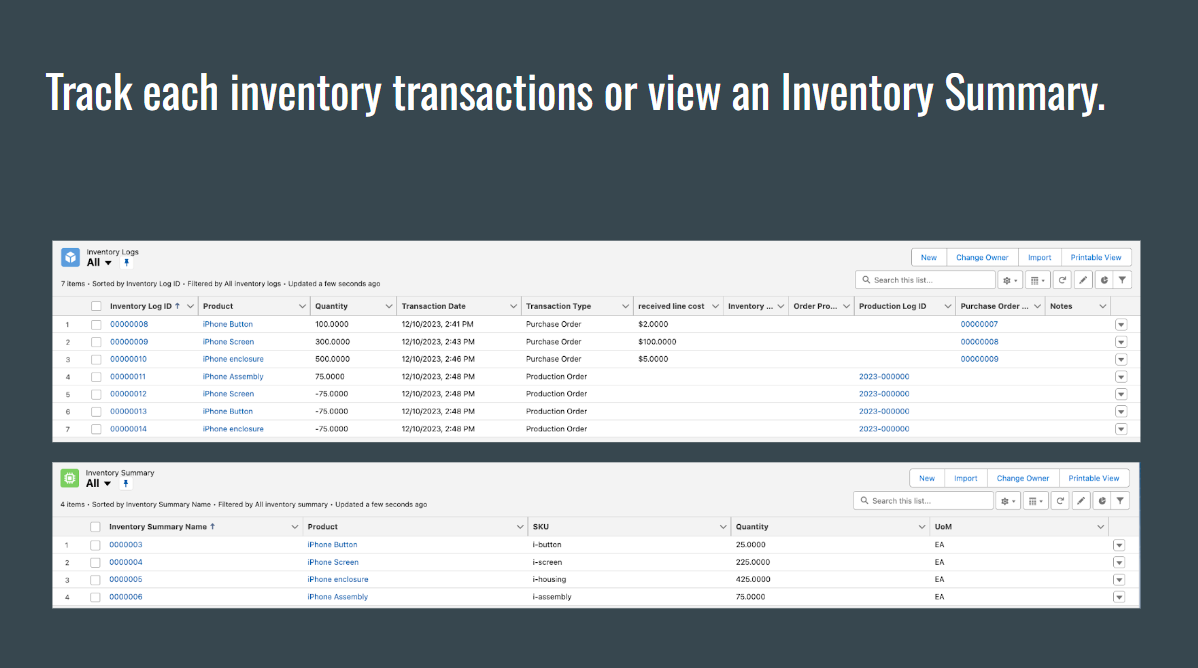Understanding the Importance of Inventory Management in Supply Chains
In today’s fast-paced business world, efficient supply chain management is critical for success. One of the core components of a smooth supply chain is effective inventory management. Companies that struggle with inventory control face challenges such as stockouts, overstocking, increased carrying costs, and lost sales opportunities. These issues can lead to customer dissatisfaction and reduced profitability.
Salesforce Inventory offers a modern, cloud-based solution designed to address these challenges by integrating inventory management directly with customer relationship management (CRM). This seamless integration between inventory and CRM systems not only simplifies supply chain operations but also enhances visibility, collaboration, and responsiveness.
What Is Salesforce Inventory?
Salesforce Inventory is an inventory management solution built natively on the Salesforce platform. Unlike standalone inventory systems, it leverages Salesforce’s robust CRM capabilities and cloud infrastructure to offer a unified platform that connects inventory data with sales, customer service, procurement, and financial operations.
This integration is especially powerful when combined with Axolt ERP, a Salesforce-native ERP solution, which further extends capabilities by providing comprehensive enterprise resource planning features directly within the Salesforce ecosystem.
By operating within the Salesforce environment, Salesforce Inventory offers businesses the advantage of real-time data synchronization, automated workflows, and centralized control over their entire supply chain.
How CRM Integration Enhances Inventory Management
Real-Time Customer and Inventory Insights
One of the biggest advantages of integrating inventory management with CRM is the availability of real-time, end-to-end insights. Salesforce Inventory allows businesses to track stock levels, order statuses, and customer interactions on a single platform.
For example, when a sales representative views a customer order in Salesforce CRM, they can immediately see available inventory, estimated delivery times, and past purchase history. This transparency helps in managing customer expectations, preventing overselling, and improving order accuracy.
Streamlined Order Fulfillment Process
Order fulfillment is a critical junction where inventory management and customer relationship management converge. Salesforce Inventory’s CRM integration enables automatic updates to inventory levels as sales orders are placed, shipped, or returned.
This synchronization reduces manual data entry and errors, accelerates order processing, and helps businesses meet delivery commitments more consistently. Customers benefit from faster service and accurate order tracking, enhancing overall satisfaction.
Enhanced Demand Forecasting and Planning
Integrating CRM data such as customer purchase patterns, preferences, and seasonality with inventory metrics enables better demand forecasting. Salesforce Inventory, especially when used with Axolt ERP, utilizes AI and analytics to analyze historical sales trends and predict future inventory needs.
Accurate forecasting helps businesses optimize stock levels, reduce excess inventory, and avoid stockouts. It also supports strategic procurement and production planning to align with market demand.
Improved Collaboration Across Departments
Supply chain management involves multiple teams including sales, procurement, warehouse, and finance. CRM-integrated inventory management facilitates collaboration by providing a single source of truth.
Teams can communicate easily about stock availability, customer priorities, and supplier lead times. This reduces delays, aligns efforts, and enhances decision-making across the organization.
Key Features of Salesforce Inventory for Supply Chain Optimization
Unified Data Platform
Salesforce Inventory consolidates data from various supply chain functions within the Salesforce ecosystem. This unified approach eliminates silos and ensures data consistency, accuracy, and accessibility.
Whether it’s customer orders, inventory stock, vendor information, or financial records, all relevant data is stored and managed in one place.
Automated Workflows and Alerts
Automation is critical for reducing operational inefficiencies. Salesforce Inventory leverages Salesforce’s automation tools to trigger reorder processes, notify stakeholders about low stock, and handle exception management.
These automated workflows help maintain optimal inventory levels and reduce the risk of human error.
Multi-Location Inventory Management
For businesses with multiple warehouses or retail outlets, managing inventory across locations is complex. Salesforce Inventory provides multi-location stock visibility and transfer capabilities, helping companies balance stock where it’s needed most.
Real-time updates ensure that inventory is allocated efficiently, reducing fulfillment delays and transportation costs.
Mobile Accessibility
Salesforce Inventory’s mobile-friendly platform allows warehouse personnel, sales reps, and field agents to access inventory data on the go. Features such as mobile barcode scanning and instant stock updates support faster cycle counts and order processing.
Mobile access also empowers remote teams to stay connected and maintain inventory accuracy regardless of their location.
Why Choose Axolt ERP for Salesforce Inventory Integration?
Comprehensive Enterprise Management
Axolt ERP extends the power of Salesforce Inventory by offering a fully integrated ERP solution built on the Salesforce platform. It combines inventory control with finance, procurement, sales, and customer service functions.
This comprehensive approach ensures that every aspect of supply chain management is connected and optimized within a single environment.
Advanced Analytics and AI Capabilities
Axolt brings advanced analytics and AI-driven insights to inventory management. By analyzing large datasets from sales, inventory, and supplier networks, Axolt helps businesses uncover trends, predict demand, and make informed procurement decisions.
This results in improved inventory turnover and reduced costs.
Streamlined Procurement Processes
Managing supplier relationships and purchase orders can be cumbersome without integration. Axolt ERP streamlines procurement by automating vendor approvals, purchase order creation, and invoice reconciliation, all while updating inventory in real time.
This ensures that replenishment cycles are efficient, reducing stockouts and improving cash flow management.
Scalability and Flexibility
Axolt ERP is highly scalable, making it suitable for growing businesses with complex inventory needs. Whether managing serialized inventory, batch tracking, or multiple product lines, Axolt can be configured to support diverse business models and evolving supply chains.
Its native Salesforce foundation guarantees continuous innovation and integration with new Salesforce capabilities.
Practical Benefits of Using Salesforce Inventory and Axolt ERP
Reduced Inventory Costs and Waste
By optimizing stock levels through accurate forecasting and real-time monitoring, businesses can reduce excess inventory and waste. This leads to lower carrying costs and minimizes losses from obsolete or expired products.
Improved Customer Experience
Accurate inventory data linked to customer orders ensures that businesses fulfill orders correctly and on time. The transparency provided by CRM integration also enables better communication with customers regarding availability and delivery.
Increased Operational Efficiency
Automated workflows and unified data reduce manual tasks and errors, freeing up staff to focus on strategic activities. Enhanced collaboration across departments accelerates problem resolution and process improvements.
Enhanced Business Agility
Real-time data and AI insights empower businesses to respond quickly to market changes, supply chain disruptions, or customer demands. Salesforce Inventory and Axolt ERP support flexible, data-driven decision-making that keeps companies competitive.
Implementing Salesforce Inventory: Best Practices
Conduct a Comprehensive Needs Assessment
Understanding current supply chain challenges and future growth plans is essential before implementation. Identify key pain points, inventory processes, and integration requirements to align Salesforce Inventory with business goals.
Engage Cross-Functional Teams
Successful deployment involves collaboration across sales, procurement, warehouse, finance, and IT teams. Engaging stakeholders early ensures the solution addresses varied needs and gains organizational buy-in.
Customize Workflows and Automation
Leverage Salesforce’s flexible platform to tailor workflows, alerts, and automation to your specific inventory policies and processes. This customization maximizes efficiency and user adoption.
Invest in Training and Change Management
Proper training on Salesforce Inventory and Axolt ERP features is vital. Continuous support and clear communication help staff adapt and fully utilize the new system.
Monitor Performance and Iterate
After implementation, regularly review inventory KPIs such as turnover rates, stock accuracy, and fulfillment times. Use these insights to refine processes, automation rules, and data quality initiatives.
Conclusion
The power of Salesforce Inventory lies in its ability to unify inventory management with CRM, providing a comprehensive, cloud-native solution for supply chain optimization. When enhanced with Axolt ERP, this integration extends to full enterprise management, combining inventory, sales, finance, and procurement into a seamless workflow.
By leveraging real-time data, automation, AI-driven forecasting, and mobile access, businesses can streamline their supply chain operations, reduce costs, and enhance customer satisfaction. Salesforce Inventory with Axolt represents a strategic investment for modern enterprises seeking agility, efficiency, and competitive advantage in today’s dynamic market environment. Embracing this integrated solution unlocks the full potential of your supply chain, empowering your business to thrive now and into the future.















